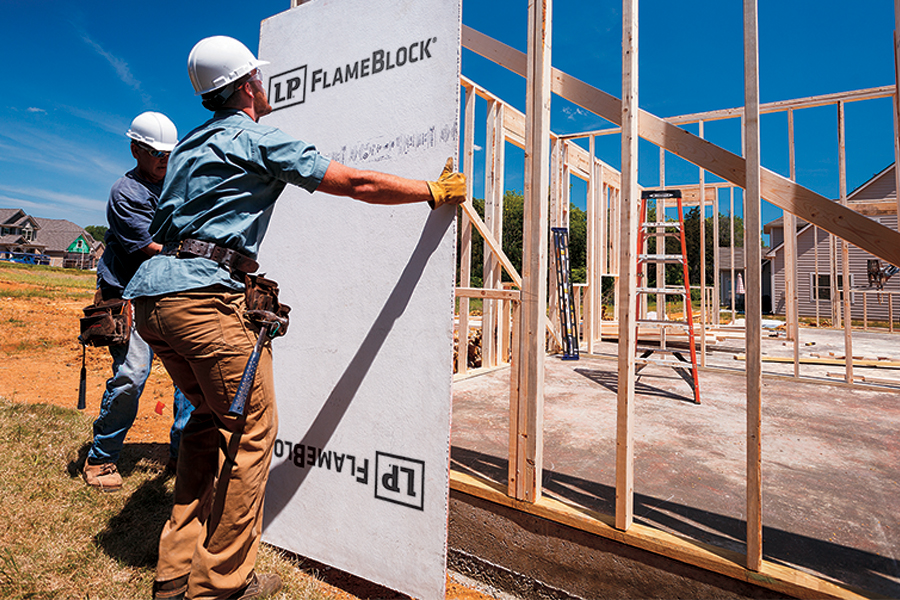News & Stories4 min
How is the Past Impacting the Future of the Building Industry?
As a leader in building solutions, LP Structural Solutions is consistently moving in the direction of greater resiliency. Each innovative building solution is viewed through that lens, as well as how it can help achieve LP’s overall goal of Building a Better World™.
But why this direction? What led LP to focus on resilience in construction? Craig Miles, Director of OSB Sales & Marketing, explores how past trends inform LP's work on modern building techniques today.
The Rise of Severe Weather Events
According to data from the National Oceanic and Atmospheric Administration (NOAA), 2020 included 20 billion-dollar severe weather events, up from an average of 14 events over the last three years and 8.5 events in the 2010s. Given that the average number of severe weather events in the 1980s was only 1.6, it’s clear that severe weather events that cost over one billion dollars in recovery funding are becoming much more common.
"Those 20 events in 2020 did about 74 billion dollars in damage," says Miles. "Currently, the world is under a resiliency threat from nature." As weather events attack the strength and structure of buildings and homes, Miles sees a way to combat the damage.
While you can never prevent all damage a storm brings, modern building techniques, including using products designed for resiliency, can help. “If you could shrink the perimeter of damage by building with greater resiliency, the cost of damage would decrease,” Miles adds.
A New Take on Resilience in Construction
"We define resiliency in a broader context," Miles says. "Resiliency means not only that your home won't get knocked down, but how resilient is your home to unpredictable factors?" Under that definition of resiliency many factors beyond weather come into play, though the prevention of weather damage is still critical.
For example, for the homeowner resiliency means defending against ever-changing energy costs by having building materials in place that are always contributing to energy efficiency. It even means having a strong sub-floor in place that will last as you simply live, work and play inside your home.
"I like to say a home needs to be resilient to your children," Miles says with a chuckle. "But ultimately, it needs to stand up to age and the passage of time." Resiliency also plays into the costs of maintenance to a home as well as repairs to HVAC systems and more-any factors that could affect a home that are outside the builder or homeowner's control.
Innovative Building Solutions**: The Portfolio Approach**
“The biggest value that the LP Structural Solutions portfolio offers is helping builders attempt to build better structures that can stand up to the ravages of the environment,” Miles says.
The portfolio allows builders to analyze the particular threats posed in the area in which they're building and choose products that will help mitigate risk. "It adds value because a builder can use the right products for each area, all from one supplier," Miles adds.
For example, LP WeatherLogic® Air & Water Barrier was recently designated by APA as Structural I Rated Sheathing, offering greater cross-panel strength and stiffness for both wall and roof applications. It’s a great choice for areas that are more susceptible to earthquakes, but builders must also consider what other threats to resiliency that structure might have. LP Legacy® Premium Sub-Flooring can contribute to overall strength, and LP® FlameBlock® Fire-Rated Sheathing could add a layer of fire resistance, which is especially useful in wildland-urban interface (WUI) areas that require adherence to specific codes.

Building in cities like Seattle, Miami and New York will all represent different resiliency needs, but from LP® TechShield® Radiant Barrier to LP WeatherLogic panels, LP provides a variety of solutions that help builders use modern building techniques in uniquely resilient structures.
Why Partner With LP?
Because addressing resilience in construction is a nuanced problem, LP Building Solutions has provided a nuanced answer: a portfolio of solutions designed to work together depending on the type of protection each build requires.
“LP has done the work for you,” Miles says, showing that LP has worked to provide innovative building solutions that make resiliency possible anywhere you build.
Check out the LP Structural Solutions portfolio of innovative building solutions and contact a dealer here.
Continue Reading
Resiliency Solutions
5 minIntroducing LP® SmartSide® ExpertFinish® Naturals Collection™: Nature-Inspired Beauty Meets Engineered Performance
We’re excited to introduce the LP® SmartSide® ExpertFinish® Naturals Collection™, a bold new addition to our trusted line of engineered wood siding and trim that delivers the warmth and beauty of nature with the advanced protection and performance builders and homeowners expect.
Labor Solutions
5 minChoosing the Right LP® Structural Solutions Product for Your Build
When it comes to building strong, reliable, and high-performing structures, the materials you choose matter. At LP Building Solutions, we understand that every project, whether it's a single-family home or a multifamily development, requires structural components that meet your needs for strength, durability, and efficiency.
Sustainability Solutions
5 minBuilding a More Sustainable Future with LP Building Solutions
In today's world, sustainability is no longer just a buzzword, it's a blueprint for responsible living and smarter building. As the construction industry seeks ways to reduce its environmental footprint, LP Building Solutions is focused on providing innovative building materials for eco-conscious builders to help reshape what it means to build sustainably
News & Stories3 min
History of Partnership with Gary Sinise Foundation
The LP Foundation is a proud partner of the Gary Sinise Foundation, which supports wounded veterans in several ways. You can learn more about the LP Foundation here.